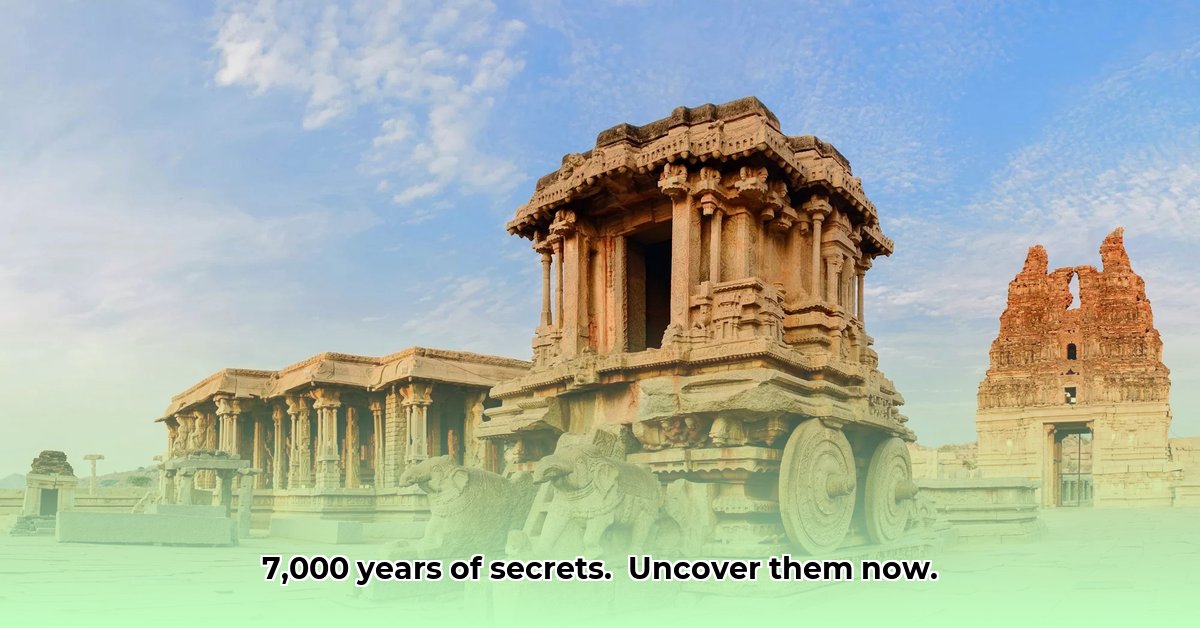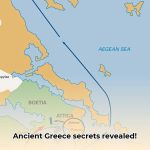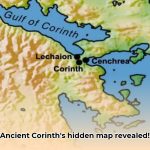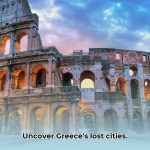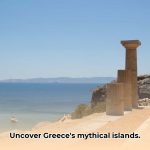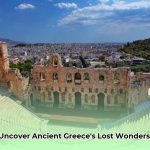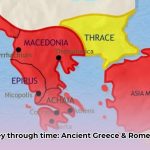Have you ever heard of Argos? It’s more than just a footnote in history. This ancient Greek city’s story stretches back millennia, from its mythical origins to its fierce battles with Sparta, profoundly shaping the course of ancient Greece. Let’s delve into its captivating past, uniting archaeological discoveries with ancient narratives, clarifying historical complexities, showcasing architectural grandeur such as the magnificent amphitheater and the revered Heraion, and tracing Argos’s lasting legacy.
Ancient Argos: A 7,000-Year Journey Through Time
Journey with us to uncover the rich narrative of Ancient Argos, a city boasting a 7,000-year history. Its story is woven from threads of Neolithic settlements, the splendor of the Mycenaean era, and the reverberations of powerful empires. Embark on an exploration through time.
From Humble Beginnings: A Neolithic Archaeological Story
Envision a time thousands of years ago, before imposing palaces and grand temples, when the first Argives began to inhabit the land. Around 5000 BCE, during the Neolithic period, settlements began to emerge on the Aspis and Larissa hills. Archaeological excavations have unearthed pottery shards, rudimentary tools, and the foundations of dwellings, offering intriguing glimpses into the daily life of these early Argives. What role did agriculture play, and how were their communities organised? Ongoing discoveries continually reshape our understanding of these pioneers, adding new layers to our knowledge base.
The Mycenaean Era: Argos Takes Center Stage in Ancient Greece
By the Mycenaean era (1600-1100 BCE), Argos had risen to prominence, transforming into a significant center of power and influence. Its strategic location on the fertile Argolid plain offered a major advantage. This agricultural wealth and key geographic position made it a significant player in the often-brutal world of ancient Greek city-states. Some historians posit that Argos rivaled even Mycenae in terms of regional influence. Written records, including mentions in Homer’s epics, alongside the discoveries of imposing tombs and cyclopean walls, paint a portrait of a rich and complex society, one that evolved through periods of monarchy, oligarchy, and nascent democratic rule. Political life in Argos was anything but static.
King Pheidon: Myth or Mastermind Ancient Ruler?
King Pheidon remains an enigmatic and debated figure in Argive history. Legends and fragmented historical accounts credit him with sweeping reforms and even the creation of a short-lived Argive empire in the 7th century BCE. Separating historical fact from embellished legend proves challenging. Some portray him as a near-mythical king who forged a powerful empire, standardizing weights and measures and introducing hoplite warfare. Others remain cautious, pointing to the limited and often contradictory evidence. Historical records are fragmented, and the true extent of Pheidon’s control is a matter of ongoing debate among historians. Perhaps he was a strong and innovative ruler, but not the all-conquering emperor of popular imagination. This underscores the inherent challenges in interpreting incomplete and biased ancient texts.
Art and Architecture: A Visual Legacy in Stone
Argos served as a fertile ground for artistic creativity and architectural innovation. The city fostered a rich artistic tradition, producing renowned sculptors like Polykleitos and Polymedes, whose works were celebrated throughout the Greek world. Incredible ruins survive to this day—the Heraion, a magnificent temple dedicated to Hera, protector of Argos; the immense amphitheater, one of the largest in ancient Greece; and the foundations of the Temple of Apollo. These impressive structures, along with the stunning artifacts housed in the Archaeological Museum of Argos, showcase a vibrant culture and the remarkable achievements of the Argives, creating a lasting visual legacy.
Beyond Antiquity: A City’s Enduring Spirit and Byzantine Influence
Argos demonstrated remarkable resilience, surviving the decline of the classical world and passing through periods of Roman, Byzantine, Venetian, and Ottoman rule. Each wave of conquerors and settlers left their distinctive mark, gradually shaping its architecture, demographics, and cultural identity. For example, the influx of Albanian settlers during the Ottoman era significantly altered the city’s population and may have subtly influenced its urban design. Modern historians continue to explore this complex period, carefully piecing together the later chapters of Argos’s long history. How did the constant influx of diverse cultures impact the urban landscape and social fabric of the city?
Argos Today: Connecting the Past and Present Civilization
From its humble Neolithic settlements to its vibrant modern incarnation, Argos stands as a testament to human resilience and adaptability. Today’s Argos rests directly upon the foundations of the ancient city, providing a tangible and living link to its rich and layered past. Exploring its archaeological sites and museums feels like engaging in a direct conversation with the generations of Argives who came before. It serves as a powerful reminder of the continuous human presence in this strategic region spanning millennia. The enduring legacy of Argos resonates strongly in its remaining structures, its vibrant culture, and the indomitable spirit of its people. What secrets still lie buried beneath the surface of Argos, waiting to be revealed? Future archaeological excavations and historical research promise to uncover even more of this fascinating city’s captivating story.
How did Ottoman and Venetian rule impact Argos’ urban development and Cultural Landscape?
Key Takeaways:
- Argos boasts a history spanning millennia, having witnessed the rise and fall of diverse rulers and experiencing continual urban transformation.
- Its Mycenaean roots laid the initial groundwork, but subsequent historical periods dramatically reshaped the city’s character.
- Classical Argos emerged as a powerful and influential city-state, leaving its mark on Greek history.
- Roman rule brought significant infrastructural improvements, although its overall influence fluctuated over time.
- How did Ottoman and Venetian rule impact Argos’ urban development? The Venetian period saw a focus on strengthening fortifications, while Ottoman rule brought changes to the city’s layout and architectural style. Ottoman control left an indelible mark on the cultural and urban fabric of Argos.
- The Byzantine and post-classical periods introduced additional layers of historical complexity to the city’s narrative.
- Modern Argos stands as a vibrant testament to its past, skillfully preserving its historical heritage while embracing the dynamism of contemporary life.
From Mycenaean Stronghold to Classical Powerhouse Ancient City
Envision ancient Argos as it existed 7,000 years ago. Its captivating story commences in the Mycenaean era, a time of powerful kingdoms, legendary heroes, and monumental citadels. Archaeological discoveries within Argos reveal evidence of early urban development and sophisticated engineering, its strategic location significantly impacting its long-term political and economic importance. The glory of the Mycenaeans eventually faded, but they bequeathed a rich and enduring legacy upon Argos.
The Rise and Fall of Classical Argos in Ancient Greece
Argos ascended to become a major player in Classical Greece, a tumultuous period characterized by the rise of independent city-states and intense rivalries for regional dominance. The city frequently clashed with Sparta, its powerful neighbor, its conflicts profoundly shaping the course of Greek history. Did these near constant conflicts significantly alter Argos’s urban development? Yes, to a considerable extent. The hosting of the Panhellenic Nemean Games attracted substantial trade and cultural exchange, but the recurring warfare inevitably disrupted urban growth and placed a strain on its resources. The archaeological record provides invaluable clues, offering insights into the city’s fortifications, public spaces, and residential areas.
Roman Ingenuity and Byzantine Influence on City Planning
The Romans, with their emphasis on order and efficiency, brought significant infrastructural improvements to Argos, constructing aqueducts, public baths (thermae), and imposing public structures that reshaped the urban fabric of the city. However, the extent of their overall cultural and political influence remains a topic of ongoing debate among historians, the archaeological record again offering crucial insights and nuanced perspectives. Later, Byzantine rule added yet another layer of architectural and cultural complexity to the city. But what ultimately happened as the Byzantine Empire gradually declined, its power and influence waning across the region? The city continued to evolve and adapt, demonstrating a remarkable capacity for resilience amidst shifting political and economic realities.
How did Ottoman and Venetian rule impact Argos’ urban development and Architecture?
The Venetian and Ottoman periods represent a particularly transformative era in the urban development of Argos. The Venetians, primarily concerned with securing their maritime trade routes, focused on strengthening the city’s defenses, adding imposing fortifications to the existing walls and strategically enhancing its overall military capabilities. Venetian architectural styles, characterized by their elegant designs and practical functionality, also left their distinctive mark on the city. The Ottomans, in turn, brought about more profound changes to Argos’s urban landscape. Ottoman-era mosques, bathhouses, and administrative buildings still stand as testaments to their long period of control. Changes in governance, economy, and social structures significantly impacted daily life and the overall appearance of the city. Historians continue to examine these crucial impacts through scholarly research, revealing how the city adapted to the changing demands of successive empires.
Argos Today: A Living Legacy of Past Civilizations
Modern Argos serves as a vibrant testament to its extraordinarily rich and layered history. While much has inevitably changed over the centuries, the city has skillfully retained its ancient heart, deftly integrating the diverse influences of successive civilizations spanning millennia. Simply exploring its streets and alleyways reveals its captivating past—a complex tapestry woven from myth, legend, and historical fact.
Argos’s Architectural Marvels: A Chronological Study of Building Styles and Influences and Ancient Greek Construction
Key Takeaways:
- Argos’s diverse architecture serves as a mirror reflecting the evolution of its building technology, societal values, and fluctuating socio-political landscape.
- Building styles have demonstrably evolved in close parallel with the rise and fall of successive civilizations that have left their indelible marks on the city.
- The magnificent Heraion and the imposing Temple of Apollo stand as enduring testaments to the central role of religious life in shaping Argive society and culture.
- Mysteries and uncertainties persist, particularly regarding the precise dating of certain structures and the true extent of technological innovation implemented throughout the city’s long history.
- Archaeological finds continue to offer valuable insights into the architectural heritage of Argos, although significant gaps in our understanding remain.
- Argos’s enduring architectural legacy continues to subtly shape the character and identity of the modern city.
Early Argos: Mudbrick and Mycenaean Echoes History
Envision early Argos, a settlement gradually emerging from the mists of prehistory. Its earliest buildings were relatively modest in scale, constructed primarily from sun-dried mudbrick—a testament to the early Argives’ ingenuity in utilizing locally available materials. The powerful Mycenaean civilization exerted a considerable influence on the layout of the nascent city and its early building techniques, fundamentally shaping Argos’s architectural origins.
The Rise of Stone: Temples and Theatres in Society
With increasing prosperity came the gradual replacement of mudbrick with more durable and aesthetically pleasing stone. The Heraion (a magnificent temple dedicated to Hera, the patron goddess of Argos) exemplifies the pinnacle of Argive religious architecture. Rebuilt and expanded over the course of several centuries, it eloquently demonstrates the evolving building technology and artistic expression of the Argives. The Doric (characterized by simple, sturdy columns and unadorned capitals) and Ionic orders (characterized by slender, fluted columns and decorative capitals) emerged as distinct architectural styles, reflecting a growing sophistication in design and engineering. Did the construction of these enormous and elaborate structures require a centralized authority capable of mobilizing significant resources? Probably. It clearly demonstrates the growing political and economic power of Argos.
The Ancient Theatre, with its impressive scale and ingenious design, was skillfully integrated into the natural landscape. Its careful placement on a gently sloping hillside enhanced acoustics and created a stunning visual spectacle. Imagine twenty thousand spectators gathered within its walls, their voices rising and echoing during dramatic performances and civic gatherings. Its sheer size and grandeur reflect Argos’s prominence as a leading cultural and political center of the ancient world.
Blending Styles: A Cultural Tapestry of Influences
Argos’s architecture wasn’t entirely uniform or monolithic. Argive builders frequently blended Doric and Ionic elements in their designs, demonstrating both a deep respect for tradition and a willingness to embrace new aesthetic trends. This architectural syncretism subtly reflects Argos’s extensive interactions with other Greek city-states and civilizations. Scholars continue to debate the precise nature and extent of this cross-cultural exchange, but it is clear that Argos was far from being an insular or isolated city.
The Heraion and the Temple of Apollo: Religious Centers of Power and City Planning
The Heraion, located a short distance from the city itself, served as the heart of the Heraean Games, a major Panhellenic event showcasing religious observance, athletic competition, and civic pride. The Temple of Apollo Lyceus, situated within the city proper, played a vital role in the daily religious life of the Argives, serving as a center for oracular consultations, religious festivals, and civic ceremonies. These prominent religious structures clearly demonstrate the profound influence of religious beliefs and practices in shaping Argive identity and civic life. What specific values and beliefs are reflected in the design and ornamentation of these temples? A close examination of their architectural details allows us a fascinating glimpse into the collective soul of ancient Argos.
Uncertainties and Ongoing Debates in Ancient History
While numerous impressive architectural remains survive to this day, much about the architectural history of Argos remains shrouded in uncertainty. The precise dating of certain structures is a matter of ongoing debate among archaeologists, as is the specific role played by the renowned Argive sculptor Ageladas in the design and construction of major public buildings. Fragmentary evidence, particularly from the later historical periods, means that the written accounts of ancient historians like Pausanias are of critical importance, although their interpretations are themselves subject to scholarly scrutiny. Such inherent uncertainties underscore the fact that historical research is a continuous and evolving process, with new discoveries constantly refining our understanding of the past.
Argos Today: Living Enduring Legacy of Architecture
Stepping into modern Argos, one cannot help but feel a tangible connection to the ancient city that lies beneath its streets. Past and present are inextricably intertwined, with the enduring architectural legacy of Argos skillfully preserved in stone, memory, and the enduring cultural identity of its people.
Argos and its Neighbors: Diplomatic Relations and Military Conflicts in Ancient Greece’s City States
Key Takeaways:
- Argos boasts a history stretching back millennia, a narrative characterized by periods of both immense power and gradual decline.
- Its strategic geographic location has profoundly shaped its historical trajectory, offering both substantial economic opportunities and significant military advantages.
- The complex and often turbulent relationships with its powerful neighbors, including Sparta, Corinth, and Mycenae, involved a shifting mix of military conflicts, strategic alliances, and uneasy truces.
- The city’s volatile internal political landscape frequently swayed its foreign policy, leading to unpredictable shifts in allegiance and strategic objectives.
- The enduring legacy of Argos provides invaluable insights into the intricate workings of the ancient Greek world and the complex dynamics of inter-city-state relations.
A City Forged by Geography and Military Strategy
Imagine Argos nestled in the heart of the fertile Argolid plain, blessed with abundant harvests and readily accessible to vital trade routes. Its strategic geographic position—controlling key sea access points and dominating important land routes—was both a tremendous blessing and a significant curse. The city’s economic prosperity inevitably drew the envious eyes of its neighbors, frequently leading to territorial disputes and protracted warfare. Did this fertile land and strategic location ultimately prove to be a blessing for Argos, or did its natural advantages become more of a curse, attracting constant conflict and instability? The city repeatedly found itself battling against its neighbors for control of vital territory and scarce resources, its history defined by an almost constant state of military preparedness.
The Rise of a Powerful Rival: Sparta as an Ancient Enemy
Argos’s long and often bitter rivalry with Sparta fundamentally shaped its historical trajectory. These powerful city-states repeatedly clashed in a series of brutal conflicts, their animosity symbolizing the deep-seated tensions that frequently divided the Greek world. Argos and its Neighbors: Diplomatic Relations and Military Conflicts in Ancient Greece were often defined by mutual suspicion and outright hostility. At times, necessity dictated that they form temporary alliances against common enemies, only to quickly return to a state of open warfare. What ultimately fueled this seemingly endless cycle of friction?
Internal Politics: A Shifting Tide and Political Tensions
The internal political scene in Argos was notoriously dynamic and often volatile. Did democracy or oligarchy primarily dictate the city’s strategic choices and foreign policy objectives? Argos experimented with numerous forms of government throughout its history, from early monarchies to periods of democratic governance and oligarchic rule. This internal volatility frequently exerted a significant influence on its foreign policy, leading to unpredictable shifts in allegiance and strategic orientation. Navigating these turbulent political waters was akin to captaining a ship constantly battling against powerful storms.
The Mycenaean Legacy: A Shared Heritage of Ancient Greece?
Argos’s early history is inextricably linked to the rise and fall of the Mycenaean civilization. What was the precise nature of this connection, and how did it shape the city’s subsequent development? Was there a relatively smooth transition from Mycenaean rule to the emergence of Argos as an independent city-state, or did the collapse of the Mycenaean world lead to significant disruption and cultural discontinuity? Archaeological finds within Argos offer tantalizing hints, but definitive answers remain elusive. Uncovering the city’s complex cultural inheritance is crucial to fully understanding its unique historical identity.
Argos in the Hellenistic Age: A New Chapter and Cultural Exchange
The conquests of Alexander the Great ushered in a fundamentally new era for Argos, as for the rest of the Greek world. Argos played a somewhat different role during this period, becoming a member of the League of Corinth, a political organization dominated by the expanding Macedonian kingdom. But what did this shift ultimately mean for its long-term political and cultural identity? Did it mark a period of relative subordination to Macedonian power, or did the city manage to retain a significant degree of autonomy and cultural independence? Historians continue to carefully study this complex transition, debating the subtle nuances of its evolving relationship with the larger Hellenistic world.
A Lasting Legacy: From Antiquity to Modernity and Cultural Identity
The enduring legacy of Argos stands as a powerful testament to its historical significance and its lasting contributions to the development of Greek civilization. Though no longer a dominant regional power, the modern city thrives, skillfully blending its ancient grandeur with the vibrant dynamism of modern life. The echoes of its rich and layered past continue to resonate strongly even today, reminding us of the enduring power of human history.
- Uncover Ancient Arcadia: Myths, Power, and Geography - August 12, 2025
- Explore Ancient Olympia’s Map: Unveiling 2,500 Years of History - August 12, 2025
- Discover Ancient Greece’s Islands: A Timeless Journey Through History and Myth - August 12, 2025
